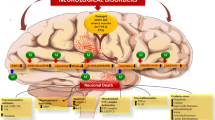This article considers new data on the key molecular mechanisms which may underlie the neuroprotective properties of multicomponent organ-specific medicinal formulations consisting of peptide hydrolysates extracted from animal brains. Such formulations, including cortexin, are currently quite widely used in the treatment of cerebral pathologies. The potential molecular mechanisms of the neuroprotective effects of cortexin are shown to be diverse and to influence key processes underlying neuroplasticity: signal transduction, energy metabolism, proteolytic modification of proteins, brain cell structures, and neuroinflammation processes. The pleiotropic nature of the mechanisms of action of cortexin results from the composition of the formulation, which contains a multitude of different neuropeptides. The tissue specificity of the molecular mechanisms identified here to a significant extent determines the efficacy of the agent in cerebral pathologies.
Similar content being viewed by others
References
K. A. Witt, T. J. Gillespie, J. D. Huber, et al., “Peptide drug modifications to enhance bioavailability and blood–brain barrier permeability,” Peptides, 22, No. 12, 2329–2343 (2001), https://doi.org/https://doi.org/10.1016/s0196-9781(01)00537-x.
L. Malavolta and F. R. Cabral, “Peptides: important tools for the treatment of central nervous system disorders,” Neuropeptides, 45, No. 5, 309–316 (2011), https://doi.org/https://doi.org/10.1016/j.npep.2011.03.001.
I. Gozes, “Neuroprotective peptide drug delivery and development: potential new therapeutics,” Trends Neurosci., 24, No. 12, 700–705 (2001), https://doi.org/https://doi.org/10.1016/s0166-2236(00)01931-7.
N. V. Gulyaeva, “Molecular mechanisms of neuroplasticity: an expanding universe,” Biochemistry, 82, No. 3, 237–242 (2017), https://doi.org/https://doi.org/10.1134/S0006297917030014.
I. P. Ashmarin, “Potentials for the practical application and some basic studies of small regulatory peptides,” Vopr. Med. Khim., 30, No. 3, 2–7 (1984).
I. P. Ashmarin, S. A. Chepurnov, and A. P. Kulaichev, “Cascade unidirectional regulatory processes of short-lived peptides,” Fiziol. Zh,, 75, No. 5, 627–632 (1989).
S. V. Koroleva and I. P. Ashmarin, “A functional continuum of regulatory anxiety-enhancing peptides. The search for complexes providing the optimal basis for developing inhibitory therapeutic agents,” Neurosci. Behav. Physiol., 36, No. 2, 157–162 (2006).
O. A. Gomazkov, “Cortexin: molecular mechanisms and targets for neuroprotective activity,” Zh. Nevrol. Psikhiat., 115, No. 8, 99–104 (2015).
M. Brainin, “Cerebrolysin: a multi-target drug for recovery after stroke,” Expert Rev. Neurother., 18, 1–7 (2018), https://doi.org/https://doi.org/10.1080/14737175.2018.1500459.
M. Yu. Stepanichev, M. V. Onufriev, D. I. Peregud, et al., “Effects of cortexin on free-radical oxidation and inflammatory processes in rats with normal and accelerated aging,” Neirokhimiya, 35, No. 2, 187–198 (2018), https://doi.org/https://doi.org/10.7868/S1027813318020127.
V. A. Aniol, Yu. A. Novitskaya, T. N. Borodina, et al., “Assessment of the antiepileptic effects of cortexin in a model of convulsive activity,” Zh. Nevrol. Psikhiat., 111, No. 12, 68–73 (2011).
N. V. Gulyaeva, “Staging of changes in neuroplasticity in epileptogenesis using temporal epilepsy as an example,” Zh. Nevrol. Psikhiat. (spec. iss.), 117, No. 9, 10–16 (2017), https://doi.org/https://doi.org/10.17116/jnevro20171179210-16.
A. A. Yakovlev and N. V. Gulyaeva, “The pleiotropic functions of brain proteinases: methodological approaches to studies and the search for the substrates of caspases,” Biokhimiya, 76, No. 10, 1079–1086 (2011), https://doi.org/https://doi.org/10.1134/S0006297911100014.
A. A. Yakovlev and N. V. Gulyaeva, “Possible role of proteases in preconditioning of brain cells to pathological conditions,” Biochemistry, 80, No. 2, 163–171 (2015), https://doi.org/https://doi.org/10.1134/S00062979.15020030.
A. A. Yakovlev, A. A. Lyzhin, L. G. Khaspekov, et al., “Peptide drug cortexin inhibits brain caspase-8,” Biomed. Khim., 63, No. 1, 27–31 (2017), https://doi.org/https://doi.org/10.18097/PBMC2017630127.
Author information
Authors and Affiliations
Corresponding author
Additional information
Translated from Zhurnal Nevrologii i Psikhiatrii imeni S. S. Korsakova, Vol. 118, No. 10, Iss. 1, pp. 93–96, October, 2018.
Rights and permissions
About this article
Cite this article
Gulyaeva, N.V. Molecular Mechanisms of the Actions of Brain Peptide-Containing Drugs: Cortexin. Neurosci Behav Physi 49, 1067–1070 (2019). https://doi.org/10.1007/s11055-019-00839-4
Published:
Issue Date:
DOI: https://doi.org/10.1007/s11055-019-00839-4




